
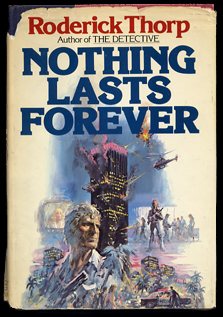 If you’re like me, you’ve wondered for years how much Bruce Willis’s DIE HARD (1988) owes to the book it was based on, NOTHING LASTS FOREVER by Roderick Thorp. And then you bought the book on e-bay but didn’t get around to reading it for a while because of an addiction to Richard Stark novels. But now you finally read the whole thing, rewatched DIE HARD and are ready to share with the world a comparison of the movie to the novel. Me and you, we’re in this together, like Bruce and Sam in part 3. We’re gonna do this.
If you’re like me, you’ve wondered for years how much Bruce Willis’s DIE HARD (1988) owes to the book it was based on, NOTHING LASTS FOREVER by Roderick Thorp. And then you bought the book on e-bay but didn’t get around to reading it for a while because of an addiction to Richard Stark novels. But now you finally read the whole thing, rewatched DIE HARD and are ready to share with the world a comparison of the movie to the novel. Me and you, we’re in this together, like Bruce and Sam in part 3. We’re gonna do this.
The “ultimate Die Hard dvd” has little mention of the original novel, other than director John McTiernan admitting he never read it. And a quick internet search (a research technique I expect to see in DIE HARD 4.0 if they ever really make it) brings up no detailed comparisons between the movie and the bool. But I’m sure there must be one out there somewhere. Fortunately, I am a fuckin pro at this shit. I done this for myself with MILLION DOLLAR BABY, POINT BLANK/PAYBACK, THE OUTFIT, two Seagal movies, and others. Also I have a commitment to excellence. So I guarantee this will be the #1 DIE HARD/NOTHING LASTS FOREVER comparison on the internet.
ENTER JOE LELAND
The book is about Joe Leland, not John McClane, a retired (not vacationing) cop going to visit his daughter (not wife) in L.A. at Christmas time. In the movie he’s estranged from his wife, in the book he was divorced from his wife and she later died. His daughter used to be married to a chump he didn’t like and has taken his name, Generro (in the movie that’s his wife’s maiden name that she uses at work).
Like in the movie, Leland is on the outskirts of an office party with his shoes off (washing his feet though, because he was told it keeps you from being tired at the end of a day) when he hears gun shots, because terrorists have taken the office hostage. He spends the rest of the book as a fly in the terrorist’s ointment, picking them off one by one, blowing shit up, communicating with them and police on the outside using a CB. Like in the movie, the terrorists are German, and sometimes talk in German so he won’t understand. One major difference is that the book always follows Leland, it doesn’t cut away for scenes on other floors of the building. So unless he’s spying on them, we don’t know what the terrorists are up to.
And of course there are some different subplots (a budding relationship with a stewardess he met on the plane, a survivalist type named Taco Bill who talks to him over the CB) and many of the details are changed, but the basic structure is pretty much the same. What really surprised me is most of the memorable action scenes in the movie are taken from the book:
- hanging into the elevator shaft by his gun strap
- throwing a dead terrorist out the window to attract cops (doesn’t hit the car, though)
- putting a dead terrorist in the elevator with “NOW WE HAVE A MACHINE GUN” written on his sweatshirt (the movie changed it to “I” and had the welcome addition of “HO HO HO”)
- dropping a C4 bomb strapped to a chair down the shaft and blowing out all the windows
- rapelling down the side of the building strapped to a firehose and shooting out a window to get back inside
- taping a gun to his back for the final showdown.
THE SAME, BUT DIFFERENT
Most of the characters in the movie are from the book, give or take: trusty Al Powell, bureaucratic Dwayne T. Robinson, blonde beast Karl and his dead brother. Even the treacherous yuppie cokehead Ellis comes from the book. In the movie there’s a vague hint that Hollie could be having an affair with this guy, or at least that McClane’s jealous mind could be worried about that. But in the book it’s his daughter’s co-worker, so it’s more of a fatherly “I can’t believe my daughter is fucking this asshole” kind of pain.
In the book the heavy isn’t called Hans Grueber, he’s Anton “Red Tony” Grueber, a terrorist who enjoys sitting people down and shooting them in the lapel. Also, the ages of most of the characters have been switched around at random for the movie. In the book, Leland/McClane is much older and retired. And he’s going to visit his daughter, not his wife, so she’s younger. Al Powell is 22. The limo driver, who isn’t named Argyle and who is never seen again after he drops him off, is older.
In the movie, McClane gets dirty from climbing through vents and elevator shafts. In the book he becomes completely stained, covered in black filth, which helps him to hide in the shadows. He thinks it makes him look more fearsome, but then when he sees himself on TV he worries that it just makes him look pathetic.
AND FRANK SINATRA AS JOHN MCCLANE
After enjoying 17 years of DIE HARD’s bastard sons and inbred cousins, I notice one cliche refreshingly missing from the original. There’s a point in the movie where the media identifies the terrorist leader as “this man, Hans Grueber,” and another point where Grueber learns that his foe is “Mr. officer John McClane of the New York City Police Department.” In almost all DIE HARD type movies, this is now used for the two Just How Badass Is This Guy? scenes, one for the hero and one for the villain.
What they would do is have a bunch of military or intelligence guys standing around in a room with a bunch of computers and a big screen, looking at security camera photos of Hans Grueber. And they list the different terrorist groups he’s been connected with, the bombings and assassinations he was involved in, and that he’s an expert in marskmanship, explosives, improvised weaponry, etc. And how he’s unpredictable and all that crap. Then there would be a scene for John McClane where Grueber uses a computer to find McClane’s secret files and it lists off what a badass he is, he has this medal and this medal, he is trained in this and this and this, he was in Bosnia and Mogadishu, he can tear a phone book in half, etc. Or they would say this guy’s file is empty, he has no history. It’s like he doesn’t exist. This guy has black ops written all over him.
Well DIE HARD doesn’t have either one of those scenes, there is only a little bit of backstory. For McClane, the bit of backstory you get is not about his achievements as a cop, just that his wife moved away for a career opportunity. Same thing with Grueber – we just know that the terrorist group he used to be in doesn’t want to be associated with him anymore. Creative differences or something.
 But NOTHING LASTS FOREVER is a book, so you end up having alot more backstory. In fact, the book is a sequel to an earlier Roderick novel, THE DETECTIVE, where Leland is a P.I. investigating a weird sex crime. In NOTHING LASTS FOREVER we get a summary of that case, and how he got the wrong man executed, his marriage was ruined, his wife left him and eventually died, he was an alcoholic for a while, his daughter wouldn’t speak to him, life is shit, etc. Also we learn a little bit about Leland being a pilot during the war, and a cop, and a world renowned security expert, which helps him out with this whole terrorists-in-a-building scenario.
But NOTHING LASTS FOREVER is a book, so you end up having alot more backstory. In fact, the book is a sequel to an earlier Roderick novel, THE DETECTIVE, where Leland is a P.I. investigating a weird sex crime. In NOTHING LASTS FOREVER we get a summary of that case, and how he got the wrong man executed, his marriage was ruined, his wife left him and eventually died, he was an alcoholic for a while, his daughter wouldn’t speak to him, life is shit, etc. Also we learn a little bit about Leland being a pilot during the war, and a cop, and a world renowned security expert, which helps him out with this whole terrorists-in-a-building scenario.
THE DETECTIVE was even made into a movie starring Frank Sinatra. So in a way, you can consider that movie to be a prequel to DIE HARD. But only if you can accept that Frank Sinatra as Joe Leland becomes Bruce Willis as John McClane. Which might be kind of hard. But you should try though.
(According to this article, NOTHING LASTS FOREVER was actually made after the Detective movie so they’d have a basis for a movie sequel, like THE LOST WORLD: JURASSIC PARK or BE COOL. But Sinatra turned down the movie. 15 years later, when Joel Silver decided to make it, he first offered the role to Sinatra and Robert Mitchum. Apparently it was only after they turned it down that it was decided to make it a younger character visitiing his wife).
THE JOY OF DIE HARD
On McTeirnan’s DVD commentary track he says that his main objective was to find a “joyful” way to do a movie about terrorists. It’s kind of a weird thing to say on such a dry and humorless commentary track, but it’s a fair point. He says that if the bad guy is a terrorist killing people for some political cause you just have to hate them. But if they’re just trying to get money you can have more fun watching it and admire the cleverness of their scheme. Which may be true, I don’t know.
At any rate, this decision is the one that makes the biggest change to the meaning of the book. In the movie Hans Grueber and his gang are pretending to be terrorists fighting for some vague political cause, but actually that’s a cover to help them in a robbery. In the book though they really are fighting for a political cause, and it seems possible that if Leland hadn’t become involved they could have done it without killing anyone. They say that Klaxon Oil was involved in a shady deal with the ruling junta in Chile, propping them up and taking money away from the impoverished citizens. Leland not only believes their claims, but believes his daughter was willingly involved in this corruption. But she’s still his daughter, and they’re still holding guns on her.
The terrorists plan to make public documents proving that the deal took place, then they plan to dump $600,000 in cash (part of the deal) out the windows.
(Klaxon Oil is changed to the Nakatomi Corporation in the movie, to reflect ’80s concerns about Japanese companies buying out American ones. Ironically, if they’d left it how it was in the book it would be more up to date, less dated than it is in the movie.)
But remember, the movie added joy to the book. So the book ends up much darker. When Grueber falls out the window, he hooks a finger onto Leland’s daughter’s bracelet (in the movie it’s a Rolex given as a reward for her work). But in the book, he pulls her down. Even though he’s already dead, he kills Leland’s daughter.
So Leland continues his rampage, seeks out the other terrorists in the building and kills them. And it’s not pleasant. Some of the terrorists are women, and at first this bothers him, then he starts to get used to it. The last one is described as “a little girl, plump, with rosy cheeks and green eyes.” When he pulls a gun on her, Thorp writes:
“She started to scream. Leland could see that she had never lived, that she knew she was dying without ever having experienced most of the natural course of life. Leland thought of his dead daughter Steffie and shot this bitch in the forehead above the bridge of her nose.”
At the end of the movie, there are a couple shots where the bonds and documents from the company safe blow out the windows and fall to the ground like snow. Not important at all, just a little detail. In the book, part of the terrorist plan is to throw the company’s money out the windows to the people below. Leland stops them, but since he blames the company for his daughter’s death, he himself throws all the money out the window.
And remember that scene at the end, where it seems like it’s all over, then Karl (last seen hanging from a chain like a slab of beef) stumbles out of the building like a crazed zombie and opens fire on McClane and everybody else, only to be gunned down by Al Powell? Same thing happens in the book, except Karl first hits Dwayne T. Robinson, killing him. And Powell jokes and/or hints that Leland ducked behind Robinson on purpose. As Leland is carried away, wounded, he drifts away and thinks about flying – an ambiguous ending that could mean he’s relaxing and enjoying the fact that it’s all over, or could mean that he’s dead. (There is no NOTHING LASTS FOREVER 2: NOTHING LASTS FOREVERER, after all.)
THE JOY OF BRUCE
Another part of making the movie “more joyful” was in the casting of Bruce Willis. Not that Joe Leland is humorless, but John McClane is alot more of a wiseass. Most of the smartass remarks, discussion of cowboy movies, etc. was not from the book. Some of those lines are a little corny now, 17 years later, but most of it works as the kind of black humor people really use in grim situations. And he doesn’t follow the standard kill-a-guy/make-a-pun formula of other action movies. It’s more spontaneous. I like that Bruce, while going through impossible physical punishments, is not a stone-faced super-killer. He’s scared shitless. He’s running around yelling “JESUS CHRIST!” and “FUCK ME!” every time things get bad (which is always). He may be a bad motherfucker but he doesn’t hide the fact that he’s jumping rope on thin ice.
In fact, Bruce has one line about Rambo and another one about Schwarzengger, as if to say, “this guy is not Stallone or Schwarzenegger. He’s more like us and also speaks clear English.” They’re purposely trying to position him as the alternative to those two popular-at-the-time meatheads.
Another major theme they dumped from the book actually wasn’t so dark. In the book, Leland is trying to prove that one man really can make a difference. If this old fuck can singlehandedly stop a terrorist attack, then you don’t have an excuse anymore. You CAN make the world a better place! Do it for Joe Leland!
In the movie, one man really can make a difference sort of becomes this one man sure is a bad motherfucker. Which I can’t really complain about. And I don’t know if I agree with it, but I guess you could argue that Bruce Willis being a normal guy with a receding hairline, not some lantern jawed Adonis shipped in from Europe, sort of gets the message across anyway. One Bruce Willis really can make a difference.
TAKE OUT THE GREY AREAS, ADD MORE FUN AND A HAPPY ENDING
 McTiernan’s joy-ification of the book is a little offensive from one point of view. I’m not one of those dudes that thinks anything dark is AUTOMATICALLY better than a happy ending. Like, if Pinocchio was used as a firelog or carved into a canoe at the end, I don’t think that would improve the movie just because it’s dark. I do think the end credits of SEABISCUIT should be a classroom of kids pasting their art projects together, but that’s an isolated case. Anyway, dark does not always mean better, but Roderick Thorp’s book already exists as a grim story with purposely ambiguous morality. You definitely side with Leland, but there’s a part of you that wonders about some of the things he does. And, like in many DIE HARD rip-offs, but not DIE HARD itself, the bad guys actually have a noble cause that even Leland agrees with. It’s just their methods that are fucked. So there’s more grey area there.
McTiernan’s joy-ification of the book is a little offensive from one point of view. I’m not one of those dudes that thinks anything dark is AUTOMATICALLY better than a happy ending. Like, if Pinocchio was used as a firelog or carved into a canoe at the end, I don’t think that would improve the movie just because it’s dark. I do think the end credits of SEABISCUIT should be a classroom of kids pasting their art projects together, but that’s an isolated case. Anyway, dark does not always mean better, but Roderick Thorp’s book already exists as a grim story with purposely ambiguous morality. You definitely side with Leland, but there’s a part of you that wonders about some of the things he does. And, like in many DIE HARD rip-offs, but not DIE HARD itself, the bad guys actually have a noble cause that even Leland agrees with. It’s just their methods that are fucked. So there’s more grey area there.
So it’s kind of what you expect from those Hollywood fucks, to take out the grey area, add more “fun” and a happy ending. Turn it into something it’s not. On the other hand, it’s not like they turned it into a goofy comedy. McTiernan doesn’t seem to know it, but it’s still a pretty brutal movie. The guy is running around barefoot on broken glass, covered in blood. That scene where he swings shirtless and barefoot through a broken window, then gets dragged across the floor… and what about that fight with Karl, he’s pounding on him and grunting like an animal, says “Motherfucker! I’m gonna kill you! Then I’m gonna fuck’n cook ya! Then I’m gonna fuck’n eat ya!” and then he wraps a chain around his neck and tosses him off the stairs… I mean, shit. This is not the watered down PG-13 action movie bullshit we got today.
Come to think of it, I’m not a big fan of the ’80s at all. But that’s one thing I will say for the ’80s – the days when Verhoeven was a mainstream filmatist. The movies may have been corny, the music may have been horrendous, the president may have been Ronald Reagan. But at least they didn’t water down the action movies. Good job with that one, ’80s.
McTiernan also talks on the commentary track about how he used A MIDSUMMER NIGHT’S DREAM as a guide for the plot, and had them rewrite the script so it took place all in one day, because A MIDSUMMER NIGHT’S DREAM takes place in one day. But, you know. At least he made DIE HARD.
The movie has a couple weird nods to important plot points that have been dropped from the book. In the book, Leland flirts with a flight attendant named Kathi, gets her phone number, later calls her and even gets to talk to her on the CB while he’s in the building, thanks to the media. None of this happens in the movie, but there’s a little part at the beginning where a flight attendant looks McClane up and down like hubba hubba as he’s getting off the plane.
WHAT DOESN’T LAST FOREVER?
Another weird connection between the book and the movie – they both got titles that make no sense. For seventeen years I’ve wondered why the fuck it’s called DIE HARD. I mean sure, he’s a bad motherfucker, he’s hard to kill, etc. But usually a movie title should have something to do with the content, right? Like in OUT FOR JUSTICE, Seagal is out for justice, right? ‘Cause they killed his partner. In HARD TO KILL, they really do have a hard time killing him, ’cause he wakes up from that coma and comes back for them. In UNBREAKABLE, the plot is all about how Bruce is unbreakable. It’s important.
So I always figured DIE HARD had something to do with that old saying, “old habits die hard.” But what is the old habit then? He’s not a retired cop, he’s just out of his jurisdiction, so being a cop isn’t really an old habit. Getting back together with his wife maybe. He’s been away from her and things aren’t going too well with the relationship, but then he loves her and wants to save her life. But I don’t know man, calling that an old habit kind of diminishes the love story too, like he’s just saving her because he’s used to it. So I don’t know about that interpretation either.
All you can really figure, it’s called DIE HARD because it sounds cool.
NOTHING LASTS FOREVER I don’t get either. What is it referring to that doesn’t last forever? The takeover of the building? Leland’s life? His daughter’s life? Peace on American soil? The Klaxon Oil Company being unaccountable for their criminal ways? I don’t know man, it’s kind of vague. None of those really fit very well. I don’t get it. So like with DIE HARD, that leaves you with one option: it sounds cool.
Only that can’t be it, because NOTHING LASTS FOREVER doesn’t sound cool. So you got me on this one. I got no idea.
CONCLUSION
Everybody knows what an influence DIE HARD has been on the action movies of the past decade point seven. But what’s surprising is how much of that comes straight from my man Roderick’s book. That’s why Roderick Thorp is truly The Father of Die Hard. I recommend the book to all fans of DIE HARD and DIE HARD type movies. It’s interesting to see where it all came from, and it’s a good read anyway.
[ratings]

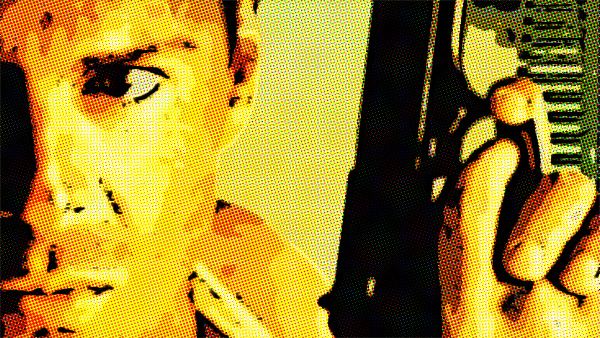
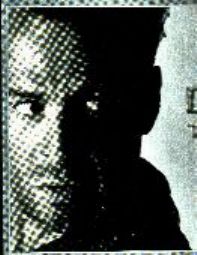 This page is to promote one of the most under recognized movies in my opinion, Bruce Willis’s DIE HARD (1988). In this movie, Bruce willis plays a cop who finds out that TERRORISTS have taken over the building of his wife’s work at christmas time. What bruce does is basically pick off the terrorists one by one, killing them, etc. These are germans with a leader named Hans Grueber. It shows that one man can take on the system BY HIMSELF. This is a big inspiration to convicts, underdogs and anyone who ever had to take on incredible odds. Also it is interesting to note that Bruce is wearing NO SHOES OR SOCKS while he takes on these Terrorists, including when he must walk over broken glass. That’s right – BARE FEET.
This page is to promote one of the most under recognized movies in my opinion, Bruce Willis’s DIE HARD (1988). In this movie, Bruce willis plays a cop who finds out that TERRORISTS have taken over the building of his wife’s work at christmas time. What bruce does is basically pick off the terrorists one by one, killing them, etc. These are germans with a leader named Hans Grueber. It shows that one man can take on the system BY HIMSELF. This is a big inspiration to convicts, underdogs and anyone who ever had to take on incredible odds. Also it is interesting to note that Bruce is wearing NO SHOES OR SOCKS while he takes on these Terrorists, including when he must walk over broken glass. That’s right – BARE FEET.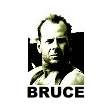 All across the world, in many different nations and cultures, families and individuals have many cherished traditions that they follow every winter holiday season. For some its the eggnog or candy canes, a special angel ornament they pass on through the family to put on top of the christmas tree, or everyone opens one present on christmas eve or who knows, ANYTHING.
All across the world, in many different nations and cultures, families and individuals have many cherished traditions that they follow every winter holiday season. For some its the eggnog or candy canes, a special angel ornament they pass on through the family to put on top of the christmas tree, or everyone opens one present on christmas eve or who knows, ANYTHING.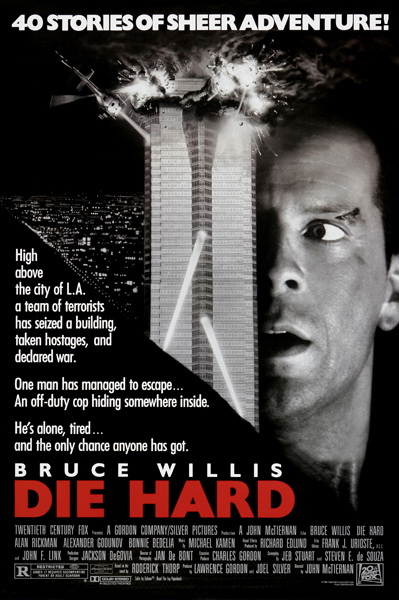 There are some items in life that only grow or blossom while others fade away or die. A man’s passion for a great film such as bruce willis’s die hard can only grow, even while his world view begins to mature. That is why a motherfucker such as myself can take a look and see how die hard no longer reflects his (my) values on the cusp of the millenium 2000, without losing ONE SINGLE ounce of respect for Mr. Bruce Willis, even outside of the tv comedies which he is most known for.
There are some items in life that only grow or blossom while others fade away or die. A man’s passion for a great film such as bruce willis’s die hard can only grow, even while his world view begins to mature. That is why a motherfucker such as myself can take a look and see how die hard no longer reflects his (my) values on the cusp of the millenium 2000, without losing ONE SINGLE ounce of respect for Mr. Bruce Willis, even outside of the tv comedies which he is most known for.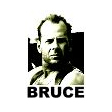 Well hell man I guess for those of you who read the title there’s no point in explaining my premise here. You see I just watched Die Hard part 2 for the first time since you know what and I realized that John McClane is a James bond for OUR people. The people who AREN’T rich and who don’t always get the breaks this motherfucker james gets.
Well hell man I guess for those of you who read the title there’s no point in explaining my premise here. You see I just watched Die Hard part 2 for the first time since you know what and I realized that John McClane is a James bond for OUR people. The people who AREN’T rich and who don’t always get the breaks this motherfucker james gets.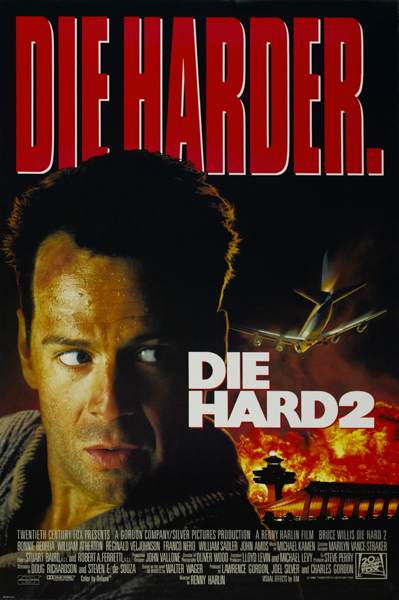 Bond has a team of experts at his disposal, but McClane just has the fax number for Reginald VelJohnson who can run fingerprints for him. Bond has this Q dude who lives in a secret lab, makes fancy gadgets for him and helps him out. McClane has a crazy janitor named Marvin who lives in a basement and finds the bad guy’s gadgets laying around and tries to sell them to McClane. Bond has the greatest possible technology at his disposal, McClane has to make a torch or tie a fire hose around his waist if he wants to get fancy.
Bond has a team of experts at his disposal, but McClane just has the fax number for Reginald VelJohnson who can run fingerprints for him. Bond has this Q dude who lives in a secret lab, makes fancy gadgets for him and helps him out. McClane has a crazy janitor named Marvin who lives in a basement and finds the bad guy’s gadgets laying around and tries to sell them to McClane. Bond has the greatest possible technology at his disposal, McClane has to make a torch or tie a fire hose around his waist if he wants to get fancy. Well I have found that a lot of my readers have also come to love the films of the Bruce Willis Die Hard series. But I wonder how many of you are in the same situation as me. Die Hard comes out in 1988, you love it. Die Hard 2 comes out a couple years later, pretty fucking good. Die Hard part 3 comes out but wait a minute, you are incapacitated and/or incarcerated at the time and are not able to ever get around to seeing the thing until letterbox video in the year 2000.
Well I have found that a lot of my readers have also come to love the films of the Bruce Willis Die Hard series. But I wonder how many of you are in the same situation as me. Die Hard comes out in 1988, you love it. Die Hard 2 comes out a couple years later, pretty fucking good. Die Hard part 3 comes out but wait a minute, you are incapacitated and/or incarcerated at the time and are not able to ever get around to seeing the thing until letterbox video in the year 2000.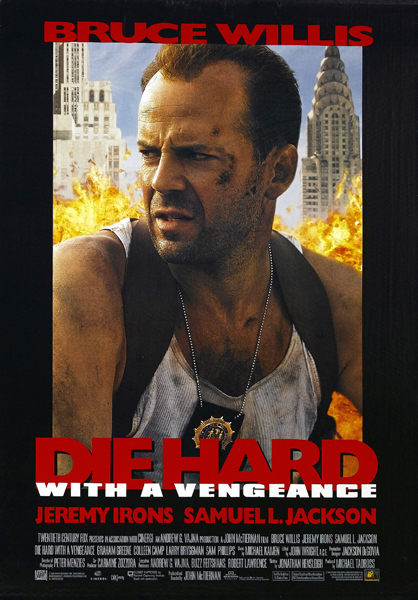 John McClane With a Vengeance is introduced in the same type of way. This time he’s suspended from the force, everyone hates him and makes fun of him. He looks like shit, he complains about his hangover, brags about his dick, and his co-workers enjoy sending him out into Harlem in his underwear wearing a sign that says “I hate niggers” (by special request from this fucker Simon.)
John McClane With a Vengeance is introduced in the same type of way. This time he’s suspended from the force, everyone hates him and makes fun of him. He looks like shit, he complains about his hangover, brags about his dick, and his co-workers enjoy sending him out into Harlem in his underwear wearing a sign that says “I hate niggers” (by special request from this fucker Simon.)























